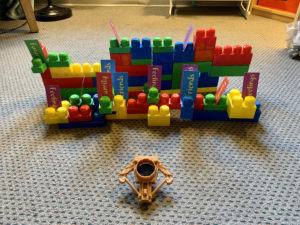How to work with the child client and others to help gain control over anxiety.
Keep your own anxiety in check
Sometimes when confronted with a highly anxious child client, we immediately want to jump into fix-it mode. We start going through a checklist of goals and directives- “Okay, we need to get you deep breathing, maybe some progressive muscle relaxation, and some mindfulness…” Sometimes we also feel pressure from those around the child wanting the child’s stress level to decrease as quickly as possible.
One of my most memorable encounters with a highly anxious child was when I first started working at an agency. My client would rock back and forth, pull his hair, and always seemed to be on high alert. Instinctively and due to my discomfort, I began discussing progressive muscle relaxation only to be shut down with a “Nope, I don’t want to.” It was a great wake-up call for me to put aside my own agenda and instead, slow down, and meet the client where the client was.
Work on Building the Relationship
It is so important to build relationships with each client. Clients displaying more severe, problematic behavior sometimes are accompanied by adults with agendas involving you fixing this behavior. This can cause a lot of stress and pressure to make progress in therapy. However, skipping the relationship-building phase could be detrimental to the therapy process. And therefore, no progress is a guarantee!
Try joining with parents over behavioral concerns while explaining why it is so important to work at the child’s pace. After all, how would they feel being brought to therapy under someone else’s agenda? And, how would you feel as a client knowing the therapist is working on fixing you because that’s what your parents/spouse wants? Be sure to save the therapy time for you client, and schedule parent consults if you need to take more time with the parents.
Understanding the Benefits of Anxiety
Clients will tell me, “I wish I wasn’t angry,” “I wish I didn’t have anxiety.” I always find it interesting to ask clients who are struggling controlling an emotion, “If I could give you a magic pill right now that would take away [insert problem emotion here] forever, would you take it?” Most of the time, and to the client’s surprise, the client will say no. Why not? Because all emotions serve a purpose.
Sometimes after an emotion has served a purpose (especially a survival purpose) the brain gets “stuck” on the emotion- utilizing it automatically for everything. This can be especially true for anxiety if something bad did happen and anxiety is serving as a defense mechanism to prevent future harm.
It’s as if anxiety says, “Hey, remember that time you got into that car accident? If I was there, you would’ve been more cautious. I’m going to stick around so you don’t get hurt ever again.” Then anxiety takes control and you find yourself paranoid all the time.
Anxiety and Control
According to Psychology Today, one of the most prevalent fears people have include loss of control or fear of lost control. “People who are chronic sufferers from such losing-control anxiety keep themselves continuously in a heightened state of stress with only brief, unsatisfying intermissions between fears.” This is what my client was showing me.
By externalizing anxiety (giving anxiety a name, a shape, and a voice), clients can feel more in control of their anxiety, instead of the other way around. One child described his anxiety as an elephant taking up the entire room. When asked what the elephant does, the child explained the elephant steps on his back and he feels like he can’t move. I discussed with the client that talking about the elephant, doing relaxation exercises, and actually talking to the elephant, could help shrink it down to an itty-bitty size. Anxiety is still there, (because all emotions serve a purpose) just not nearly as overwhelming and only after validating his anxiety was I able to introduce mindfulness (not rejecting the emotion, but acknowledging it and asking why it is there without judgement). Eventually, with mindfulness practices, I try to move clients into a conversation with anxiety such as, “I know you are there, and I know you are trying to help me, but I have control of this.” This allows clients to build a sense of mastery over their practice of emotional regulation.
Work with the Parents
Highly anxious children benefit from clear boundaries, consistent parenting, and awareness of upcoming plans. If a child is involved in a custody plan, the child should be aware of when he/she will be transitioning from one house to the next and what to expect. Sometimes it is difficult for divorced parents to work collaboratively on a parenting plan. Children can become more anxious if given inconsistent consequences or exposed to completely different parenting styles. This can result in the child displaying more problematic behaviors in one household and becoming overall more anxious.
When working with parents, therapist Kathy Eugster, MA, RCC, CPT-S, suggests parents tune into their child’s emotions and help to identify and verbalize the emotion, introduce soothing activities, and to model and encourage brave behavior.
Consult with a Physician
If possible or necessary, you may need to get a signed release to consult with the child’s physician. A child with anxiety may be misdiagnosed, may need psychiatric medications, or maybe could benefit from adjusting current medications. For example, a client may be diagnosed with ADHD, however, after working with the child, you may find that the fidgeting behaviors seem to be stemming from PTSD. The physician may not be aware of the PTSD history, and might only be exposed to the anxious symptoms such as fidgeting, talking too fast, etc. Having more eyes on the child in different settings, taking the time to gather the whole picture, and building relationships with the family and child, could help form a more holistic picture of what is going on with the child.
Resources
The Fear of Losing Control- What’s behind this fear and how you can overcome it.
https://www.psychologytoday.com/us/blog/what-would-aristotle-do/201105/the-fear-losing-control
Anxiety in Children: How Parents Can Help




I loved your ideas to externalize anxiety by giving it a name or shape so that children can talk about and control it easier. My daughter is in the fourth grade and struggles with panic and anxiety. I’d love to find a children’s therapy service to help create coping strategies similar to these ones.